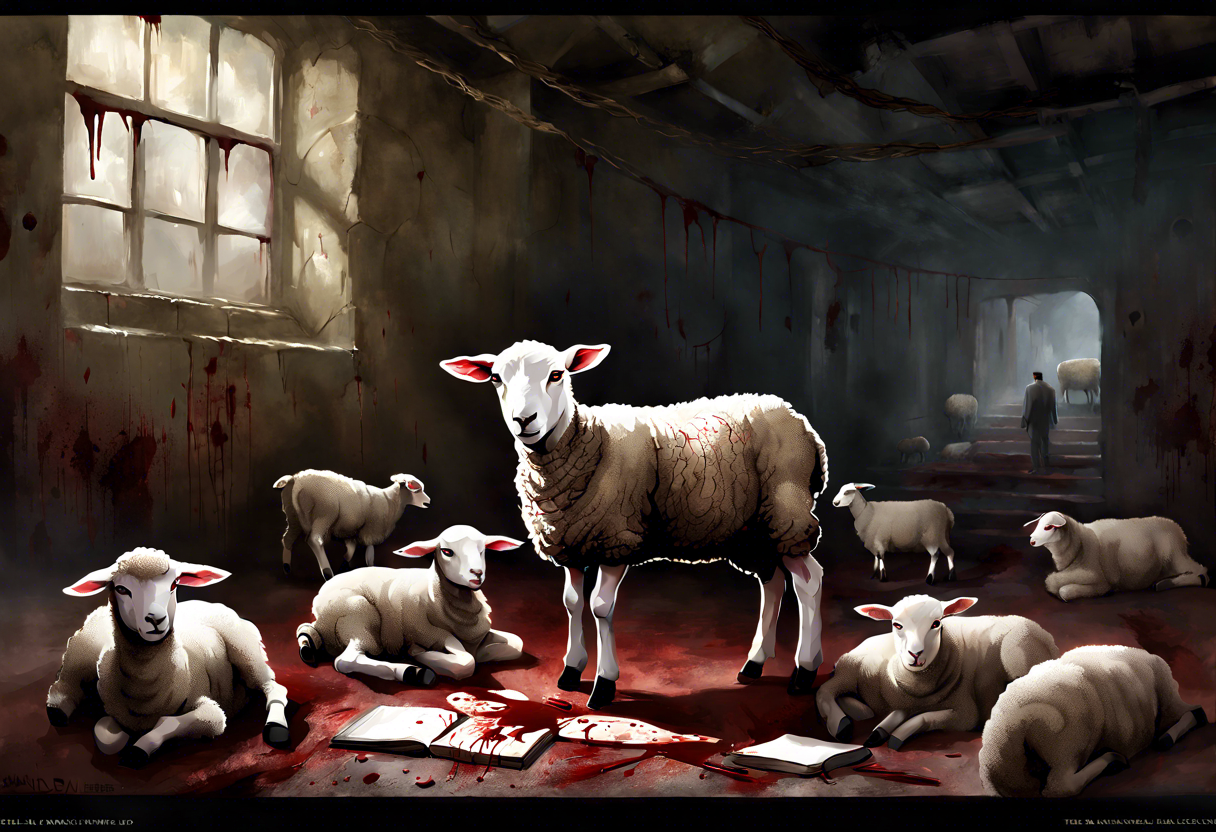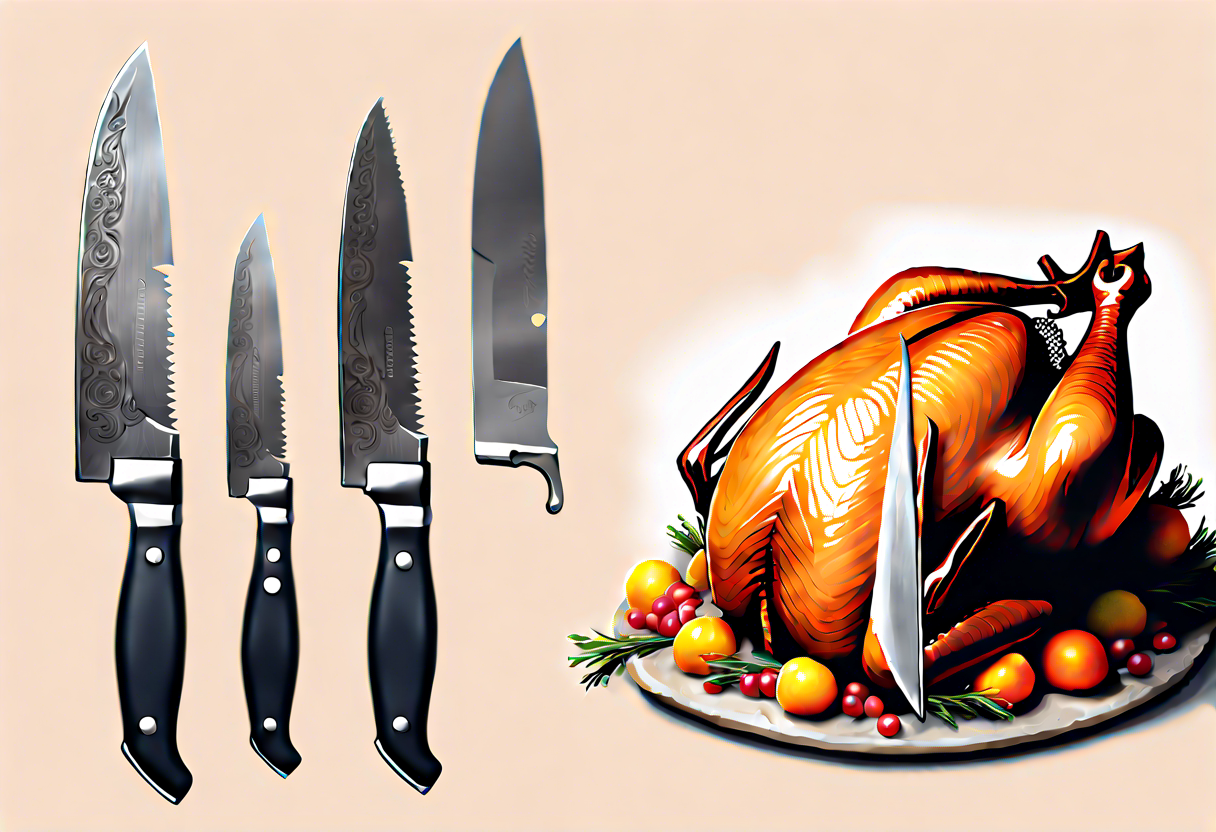Lamb to the Slaughter Summary: A Brief Overview of the Plot
In Roald Dahl’s classic short story “Lamb to the Slaughter,” we are introduced to Mary Maloney, a seemingly devoted housewife who awaits her husband’s return from work. However, her peaceful domestic life takes a shocking turn when her husband confesses to her that he is leaving her. Mary, taken aback by this revelation, resorts to using a frozen leg of lamb as a weapon, striking her husband and ultimately killing him.
The plot thickens as Mary then cleverly devises a plan to dispose of the murder weapon by cooking it and serving it to the investigating officers who are searching for the murder weapon. With her calm demeanor and innocent facade, Mary is successful in diverting suspicion away from herself, highlighting the unexpected twist in this darkly humorous tale.
As the story unfolds, we witness Mary’s quick thinking and resourcefulness in the face of adversity, showcasing a character who is capable of deception and manipulation when pushed to the edge. The narrative keeps readers on the edge of their seats as they navigate through the complexities of Mary’s actions and the consequences of her choices.
Overall, “Lamb to the Slaughter” offers a captivating and suspenseful plot that delves into the unexpected lengths a person may go to when faced with betrayal and desperation. Dahl’s storytelling prowess shines through in this tale, leaving readers both shocked and intrigued by the unraveling events.
Analyzing Mary Maloney’s Character Development in the Story
Mary Maloney, the protagonist of Roald Dahl’s "Lamb to the Slaughter," undergoes a remarkable character transformation throughout the narrative. At the beginning of the story, Mary is portrayed as a devoted and dutiful wife to her husband, Patrick Maloney, a police officer. She is depicted as a caring and loving expectant mother, eagerly awaiting her husband’s return home. Mary’s character is initially perceived as passive and submissive, embodying traditional gender roles of the time.
However, Mary’s characterization takes a sharp turn following a pivotal event: Patrick’s unexpected announcement that he intends to leave her. This revelation serves as a catalyst for Mary’s evolution from a meek and compliant housewife to a cunning and resourceful individual. In a moment of sheer panic and desperation, Mary resorts to a drastic course of action, using a frozen leg of lamb as a murder weapon to eliminate her husband.
As the narrative unfolds, Mary’s character is increasingly characterized by her quick thinking and ability to adapt to unforeseen circumstances. Despite committing a heinous act, Mary displays a cold and calculated demeanor, demonstrating her capacity for deception and manipulation. Her calm and composed behavior when questioned by the investigating officers underscores her transformation into a confident and assertive figure, capable of concealing her guilt effectively.
Furthermore, Mary’s character development in "Lamb to the Slaughter" raises thought-provoking questions about the complexities of human nature and the limits of morality. Through her actions, Mary challenges societal norms and expectations, defying traditional stereotypes of women as passive and subservient. Her portrayal serves as a commentary on the unpredictable and multifaceted aspects of human behavior, inviting readers to reflect on the blurred boundaries between right and wrong.
Mary Maloney’s character development in Roald Dahl’s "Lamb to the Slaughter" is a compelling exploration of the transformative power of unexpected events and the hidden depths of individual personality. By examining Mary’s evolution from a seemingly ordinary housewife to a determined and inventive murderer, readers are offered a nuanced portrayal of a complex and intriguing character whose actions defy conventional expectations.
Themes of Deception and Revenge in the Narrative
Themes of Deception and Revenge in “Lamb to the Slaughter” by Roald Dahl
In Roald Dahl’s short story, "Lamb to the Slaughter," the themes of deception and revenge play a crucial role in driving the narrative forward. The story revolves around Mary Maloney, who initially appears as a devoted and caring wife. However, her character takes a sharp turn after her husband, Patrick Maloney, reveals that he is leaving her. This revelation sets off a chain of events that highlight the themes of deception and revenge in the story.
Deception is evident throughout the narrative, starting with Mary’s initial demeanor of being the perfect wife. When Patrick announces his decision to leave her, Mary’s reaction is unexpected. Instead of falling apart or pleading with him to stay, she pretends that nothing is wrong and even goes to great lengths to cover up her true emotions. This act of deception foreshadows the dark turn the story will take later on.
As Mary processes the news of her husband’s departure, a sense of betrayal begins to simmer, leading to thoughts of revenge. In a moment of sheer impulse and desperation, Mary strikes Patrick with a frozen leg of lamb, ultimately leading to his death. This act of violence is not premeditated but is driven by a mix of shock, anger, and a desire to turn the tables on her unfaithful husband.
The theme of revenge is further emphasized as Mary sets out to conceal her crime and evade suspicion. She manipulates the evidence, convincing the investigating officers that her husband was killed by an intruder while she was out running errands. Her ability to deceive the authorities showcases the lengths to which she is willing to go to exact revenge and protect herself.
Throughout "Lamb to the Slaughter," Roald Dahl masterfully weaves together the themes of deception and revenge to create a compelling and darkly humorous narrative. The story serves as a cautionary tale about the consequences of betraying trust and the unpredictability of human behavior when pushed to the brink. Dahl’s exploration of these themes leaves readers questioning the lengths they would go to in similar circumstances and the thin line between love and revenge.
The Impact of Roald Dahl’s Writing Style on the Reader
Roald Dahl, known for his dark humor and twisted storytelling, has left a lasting impact on readers through his unique writing style. His ability to blend elements of suspense, irony, and black comedy creates a captivating reading experience that resonates with audiences of all ages.
Dahl’s writing style is characterized by its vivid imagery and sharp wit. He has a knack for crafting narratives that are both gripping and thought-provoking, often leaving readers on the edge of their seats. By incorporating unexpected plot twists and unconventional characters, Dahl keeps his audience engaged from start to finish.
One of the hallmarks of Dahl’s writing is his ability to tackle serious themes with a touch of humor. In "Lamb to the Slaughter," for example, Dahl explores the themes of deception and revenge in a way that is both entertaining and thought-provoking. This unique combination of light-hearted storytelling with darker undertones sets Dahl apart as a master of his craft.
Moreover, Dahl’s concise and straightforward prose makes his stories accessible to a wide range of readers. His writing is clear and to the point, allowing for quick immersion into the narrative without unnecessary distractions. This simplicity, coupled with his knack for storytelling, ensures that readers are fully engaged from the first sentence to the last.
The impact of Roald Dahl’s writing style on the reader is profound. His ability to blend dark humor with suspense, explore complex themes with wit, and craft compelling narratives with ease has solidified his place as one of the most beloved authors of our time. Through his timeless stories, Dahl continues to captivate audiences and inspire a love of reading for generations to come.
Comparing the Short Story to Other Works by Roald Dahl
Roald Dahl, a celebrated author known for his whimsical and often dark storytelling, crafted numerous works that have captivated readers of all ages. When comparing “Lamb to the Slaughter” to some of Dahl’s other notable works, such as “Charlie and the Chocolate Factory” and “Matilda,” several key differences and similarities emerge.
One of the striking variances between “Lamb to the Slaughter” and Dahl’s more children-oriented works is the tone and subject matter. While “Charlie and the Chocolate Factory” and “Matilda” are filled with fantastical elements and themes of hope and resilience, “Lamb to the Slaughter” delves into the realm of crime and deception. The dark humor and unexpected twists that Dahl is known for are present in both types of stories, though they manifest in unique ways.
Despite their thematic disparities, Dahl’s signature writing style shines through in all of these works. His concise yet vivid descriptions, clever use of dialogue, and penchant for crafting memorable characters are evident in “Lamb to the Slaughter” just as much as in his beloved children’s books. Readers familiar with Dahl’s style will find comfort in the familiarity of his narrative voice, even when exploring a more mature and sinister storyline.
Moreover, the element of surprise that Dahl expertly weaves into his tales is a common thread that runs through “Lamb to the Slaughter” and his other works. Whether it’s the shocking reveal of Mary Maloney’s calculated actions or the fantastical events that unfold in his children’s stories, Dahl excels at keeping readers on the edge of their seats and subverting expectations.
In essence, while “Lamb to the Slaughter” may stand apart from Dahl’s more lighthearted and whimsical works in terms of subject matter, it undeniably shares the author’s distinctive style and narrative flair. By comparing this short story to other pieces in Dahl’s repertoire, readers can gain a deeper appreciation for the versatility and talent of one of the literary world’s most beloved authors.
Key Takeaway:
In "Lamb to the Slaughter," Roald Dahl crafts a gripping tale that delves into the unexpected twists of human nature. The summary provides a concise overview of the plot, where Mary Maloney, the seemingly devoted wife, takes a drastic turn following a shocking revelation from her husband. The character development of Mary Maloney is a central focus, showcasing her transformation from a docile housewife to a cunning and calculated individual driven by deception and revenge. The themes of deception and revenge permeate the narrative, highlighting the lengths one may go to when pushed to the edge.
Dahl’s writing style exudes a dark humor and suspenseful atmosphere that captivates readers from start to finish. His ability to blend elements of mystery, tension, and irony creates a truly immersive experience that keeps the audience engaged throughout the story. When compared to Dahl’s other works, "Lamb to the Slaughter" stands out for its subtle yet powerful narrative arc, demonstrating the author’s versatility in crafting compelling and thought-provoking tales that resonate with readers long after the final page.
Overall, "Lamb to the Slaughter" serves as a prime example of Dahl’s mastery in storytelling, drawing readers in with its intriguing plot, complex characters, and thematic depth. It explores the darker aspects of human behavior while maintaining a sense of twisted humor that is uniquely characteristic of Dahl’s style. The impactful themes of deception and revenge, coupled with Mary Maloney’s compelling character arc, make this short story a timeless classic that continues to resonate with audiences of all generations.
Conclusion
As readers delve into Roald Dahl’s captivating short story, "Lamb to the Slaughter," they are taken on a gripping journey filled with unexpected twists and turns. The narrative opens with a seemingly idyllic scene as Mary Maloney eagerly waits for her husband, Patrick, to return home from work. However, this tranquility is shattered when Patrick delivers devastating news, leading Mary down a path of deception and revenge that ultimately changes the course of her life forever.
Mary Maloney’s character development in the story is a fascinating exploration of how circumstances can shape an individual’s actions. Initially portrayed as a devoted and doting wife, Mary’s transformation into a calculated and resourceful protagonist showcases her resilience and adaptability in the face of adversity. As she navigates the aftermath of her husband’s sudden death, Mary’s complex emotions and strategic decisions reveal a depth of character that resonates with readers long after the final page.
Themes of deception and revenge permeate the narrative, adding layers of tension and intrigue to the plot. Mary’s meticulous cover-up of her crime and her subsequent manipulation of the authorities highlight the blurred lines between justice and morality. Through Mary’s actions, Dahl masterfully explores the concept of revenge as a powerful motivator and the consequences of deceit in a tale that keeps readers on the edge of their seats until the very end.
Roald Dahl’s distinctive writing style is instrumental in creating a sense of suspense and intrigue throughout the story. His crisp prose and attention to detail draw readers into Mary’s world, immersing them in a setting that is both familiar and unsettling. Dahl’s subtle use of language and his ability to subvert expectations make "Lamb to the Slaughter" a masterclass in storytelling that continues to captivate audiences of all ages.
When compared to other works by Roald Dahl, "Lamb to the Slaughter" stands out as a prime example of his versatility as a writer. While known for his whimsical children’s stories, Dahl showcases a darker and more nuanced side in this gripping tale of crime and punishment. The seamless blend of suspense, humor, and social commentary solidifies Dahl’s reputation as a literary icon whose work transcends genres and generations.
In conclusion, "Lamb to the Slaughter" is a timeless masterpiece that continues to resonate with readers due to its compelling plot, complex characters, and thought-provoking themes. Roald Dahl’s unparalleled storytelling prowess shines through in this gripping tale of deception, revenge, and the unexpected consequences of one fateful night. Through Mary Maloney’s journey, readers are invited to explore the intricacies of human nature and the enduring power of storytelling to captivate and inspire.



